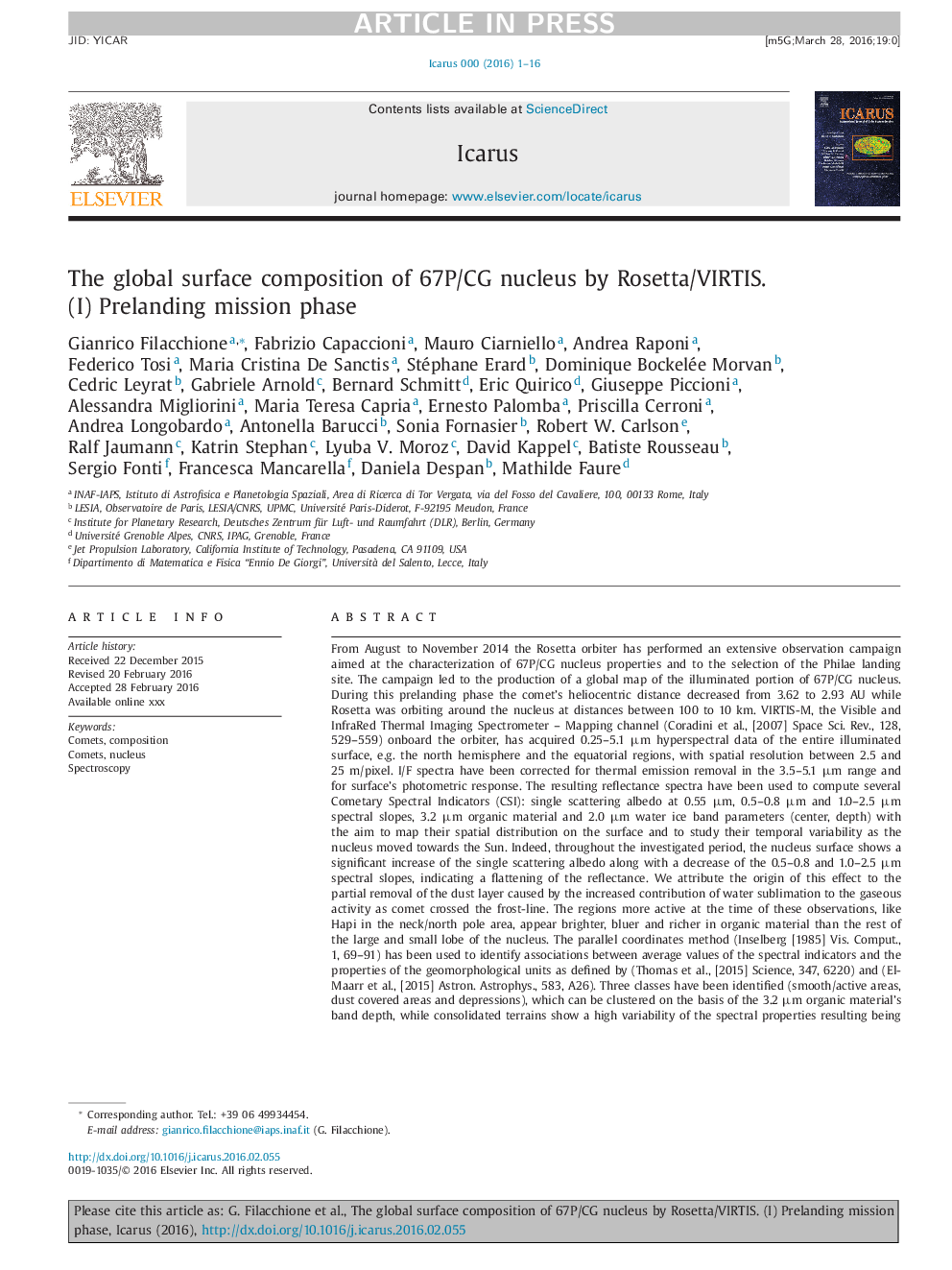| کد مقاله | کد نشریه | سال انتشار | مقاله انگلیسی | نسخه تمام متن |
|---|---|---|---|---|
| 8135023 | 1523516 | 2016 | 16 صفحه PDF | دانلود رایگان |
عنوان انگلیسی مقاله ISI
The global surface composition of 67P/CG nucleus by Rosetta/VIRTIS. (I) Prelanding mission phase
دانلود مقاله + سفارش ترجمه
دانلود مقاله ISI انگلیسی
رایگان برای ایرانیان
کلمات کلیدی
موضوعات مرتبط
مهندسی و علوم پایه
علوم زمین و سیارات
علوم فضا و نجوم
پیش نمایش صفحه اول مقاله

چکیده انگلیسی
From August to November 2014 the Rosetta orbiter has performed an extensive observation campaign aimed at the characterization of 67P/CG nucleus properties and to the selection of the Philae landing site. The campaign led to the production of a global map of the illuminated portion of 67P/CG nucleus. During this prelanding phase the comet's heliocentric distance decreased from 3.62 to 2.93 AU while Rosetta was orbiting around the nucleus at distances between 100 to 10 km. VIRTIS-M, the Visible and InfraRed Thermal Imaging Spectrometer - Mapping channel (Coradini et al., [2007] Space Sci. Rev., 128, 529-559) onboard the orbiter, has acquired 0.25-5.1 µm hyperspectral data of the entire illuminated surface, e.g. the north hemisphere and the equatorial regions, with spatial resolution between 2.5 and 25 m/pixel. I/F spectra have been corrected for thermal emission removal in the 3.5-5.1 µm range and for surface's photometric response. The resulting reflectance spectra have been used to compute several Cometary Spectral Indicators (CSI): single scattering albedo at 0.55 µm, 0.5-0.8 µm and 1.0-2.5 µm spectral slopes, 3.2 µm organic material and 2.0 µm water ice band parameters (center, depth) with the aim to map their spatial distribution on the surface and to study their temporal variability as the nucleus moved towards the Sun. Indeed, throughout the investigated period, the nucleus surface shows a significant increase of the single scattering albedo along with a decrease of the 0.5-0.8 and 1.0-2.5 µm spectral slopes, indicating a flattening of the reflectance. We attribute the origin of this effect to the partial removal of the dust layer caused by the increased contribution of water sublimation to the gaseous activity as comet crossed the frost-line. The regions more active at the time of these observations, like Hapi in the neck/north pole area, appear brighter, bluer and richer in organic material than the rest of the large and small lobe of the nucleus. The parallel coordinates method (Inselberg [1985] Vis. Comput., 1, 69-91) has been used to identify associations between average values of the spectral indicators and the properties of the geomorphological units as defined by (Thomas et al., [2015] Science, 347, 6220) and (El-Maarr et al., [2015] Astron. Astrophys., 583, A26). Three classes have been identified (smooth/active areas, dust covered areas and depressions), which can be clustered on the basis of the 3.2 µm organic material's band depth, while consolidated terrains show a high variability of the spectral properties resulting being distributed across all three classes. These results show how the spectral variability of the nucleus surface is more variegated than the morphological classes and that 67P/CG surface properties are dynamical, changing with the heliocentric distance and with activity processes.
ناشر
Database: Elsevier - ScienceDirect (ساینس دایرکت)
Journal: Icarus - Volume 274, August 2016, Pages 334-349
Journal: Icarus - Volume 274, August 2016, Pages 334-349
نویسندگان
Gianrico Filacchione, Fabrizio Capaccioni, Mauro Ciarniello, Andrea Raponi, Federico Tosi, Maria Cristina De Sanctis, Stéphane Erard, Dominique Bockelée Morvan, Cedric Leyrat, Gabriele Arnold, Bernard Schmitt, Eric Quirico, Giuseppe Piccioni,